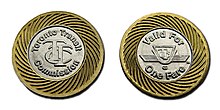Bimetal coin
A bimetallic coin or bimetallic coin (also: duplex coin ) is a coin that consists of two different, separate metals or alloys . Such coins are usually composed of a round core of one material and a surrounding ring of the other material.
This term must not be confused with bimetallism , which describes the system of a currency that is backed by two metals (mostly silver and gold ).
Coins that consist of several metals, but which only occur as a uniform alloy , are not referred to as bimetal coins. Well-known bimetal coins are the 1 and 2 euro pieces and the Thai 10 baht coin , which is very similar in appearance and weight to the 2 euro coin.
One reason for producing such duplex coins is that they are more forgery-proof than is the case with normal coins.
Manufacturing and technology
During production, the center and ring are first made as blanks , then the marginal writing is embossed on the edge of the ring, then the ring and center are placed into each other and only in the last step is the blank embossed with the coin image and thus the coin. Since the production of duplex coins is more complex than that of normal coins, it is also more expensive.
In contrast to thermal bimetals, deformation in the event of temperature changes is undesirable with bimetal coins. The materials used must therefore have identical or at least similar coefficients of linear expansion . This can be achieved through the use of appropriately composed alloys .
In the case of duplex coins of low quality, the center can slip or fall out of the ring, especially when there are large temperature fluctuations. If one were to heat a euro in hot water, one could also observe this effect, since the metals expand differently. Duplex coins with slipped centers achieve high collector prices - provided the errors are due to the minting. However, if a euro lands "just like that" in the wallet with a slipped center, it is nothing special, since this effect can be carried out many times with simple aids.
history
Duplex coins first appeared in the 1970s. For example, the Italian 500 lira pieces, which were manufactured between 1982 and 2001, are known. Since 2001, duplex coins have become more widespread, as the 1 and 2 euro coins are also made in this way. In the case of the 1 euro pieces, the ring is made of shiny golden nickel - brass and the center is made of shiny silver copper nickel . With the 2 euro piece it is exactly the other way around. Also after the duplex principle, the 2 and 5, for example, zloty -Stücken in Poland manufactured.
In the early 1990s, some types of coins were minted in Russia that look like a duplex on the outside, but are not a duplex because they do not consist of two different blank parts. They were produced with a steel core that was coated with nickel on the ring surface and brass on the center surface .
From 1996 to 2001, the Republic of Austria issued a total of nine 50-Schilling bimetal circulation coins . The outer ring consists of copper-aluminum-nickel (Cu 92, Al 6, Ni 2) and the middle of Magnimat (Magnimat 7). After the introduction of the euro currency, Austria has been issuing a 25 euro bimetal collector's coin every year since 2003 (outer ring 900 silver, center niobium ). The color of the niobium core changes from year to year.


